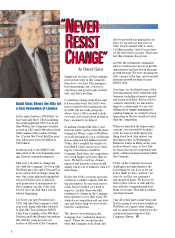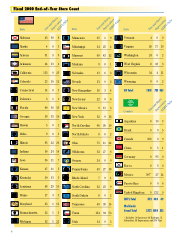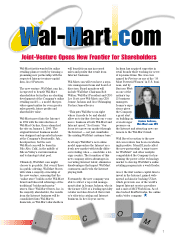Walmart 2000 Annual Report Download - page 6
Download and view the complete annual report
Please find page 6 of the 2000 Walmart annual report below. You can navigate through the pages in the report by either clicking on the pages listed below, or by using the keyword search tool below to find specific information within the annual report.
David Glass Shows the Way for
a New Generation of Leaders
In the entire history of Wal-Mart, we
have had only three CEOs including
the newly-appointed CEO, Lee Scott.
Sam Walton, the Company’s founder,
served as CEO until 1988 when David
Glass assumed the postion. During
the 12 years that David held the posi-
tion, sales grew from $16 billion to
$165 billion.
In this speech to the SAM’S Club
Associates at the year-beginning meet-
ing, David recounts his memories.
This year, I decided to change my
role with the Company. I’ve been with
Wal-Mart since the mid 1970s and I’ve
seen a great deal of change along the
way. One of my principal responsibili-
ties as CEO has been to build the
next generation of management so
this Company can rise to the next
level of success. And that’s exactly
what is happening.
Lee Scott, our new President and
CEO, will take this Company to that
next level, along with other talented
leaders like Tom Grimm at SAM’S
Club, Tom Coughlin at the Wal-Mart
Division and John Menzer internation-
ally. And the same goes for our
leaders at all levels of the Company.
Simply put, we have a better manage-
ment group today in this Company
than we’ve ever had. The managers
have momentum, size, resources,
experience and good people on their
side, and that’s exciting.
I could have changed roles later and
left soon afterward, but I felt it was
time to start the succession process.
Actually, I’m not really going any-
where. In fact, I’ll be around to help
everyone out for just about as long as
they can stand to be helped.
In making changes like this, I can’t
help but reflect on the years that have
transpired. When I came to Wal-Mart
we had just finished a year of $340 mil-
lion in sales and $12 million in profit.
Today, that’s roughly the output of a
few SAM’S Clubs, but we were work-
ing very hard then to build the
Company. Back then, our competitors
were both bigger and better than we
were. We had to catch up, change,
improve and innovate or they would
simply run us out of business. Sam led
this charge.
By the late 1970s, everyone speculat-
ed that we couldn’t compete with the
big discounters. No one took us seri-
ously, but we worked very hard to
improve. Luckily, there was little
resistance to change in the Company
then and there’s very little today. We
studied our competitors and our strat-
egy, and before long, we were better
than the competition.
The idea we were driving in the
Company was “continuous improve-
ment.” These two words describe
what this Company is all about, and
they’ve provided our principal focus
since we opened our first store in
1962. It took us until 1980 to reach
$1 billion in sales. Only 16 years later,
we hit $100 billion in sales. That’s how
fast this Company has grown.
In 1982, the investment community
said we would soon run out of growth
opportunities and needed an alternate
growth strategy. We were studying the
club concept at the time, and soon that
alternate growth strategy became
SAM’S Club.
Over time, we developed some of the
best innovations of the wholesale-club
business, including extensive apparel
and frozen-food lines. But in order to
compete effectively, we also had to
improve continuously. No one was
talking about simply managing the
existing business; we wanted to keep
improving so that we would be better
than the competition.
When we launched the Supercenter
concept, everyone said it wouldn’t
work because we didn’t know any-
thing about food. And indeed, our
first Supercenter in Washington,
Missouri, wasn’t as sharp as the com-
petition when it came to food. But
we learned from our competitors and
made continuous improvement within
the Company.
Today, as the Company faces new
challenges and opportunities, the
worst thing we can do is to let our-
selves think we have “arrived”; for
if we do, we’ll let our customers
and members down. We have to be
able to place a store or club side-by-
side with the competition and beat
them every time. That takes continu-
ous improvement.
I say all of this just to make this point:
If we’re going to reach new heights at
Wal-Mart, we cannot resist change,
and we must dedicate ourselves to the
continuous improvement of this
Company. Always.
⋆
“
N
EVER
R
ESIST
C
HANGE”
“
N
EVER
R
ESIST
C
HANGE”
by David Glass
4



















